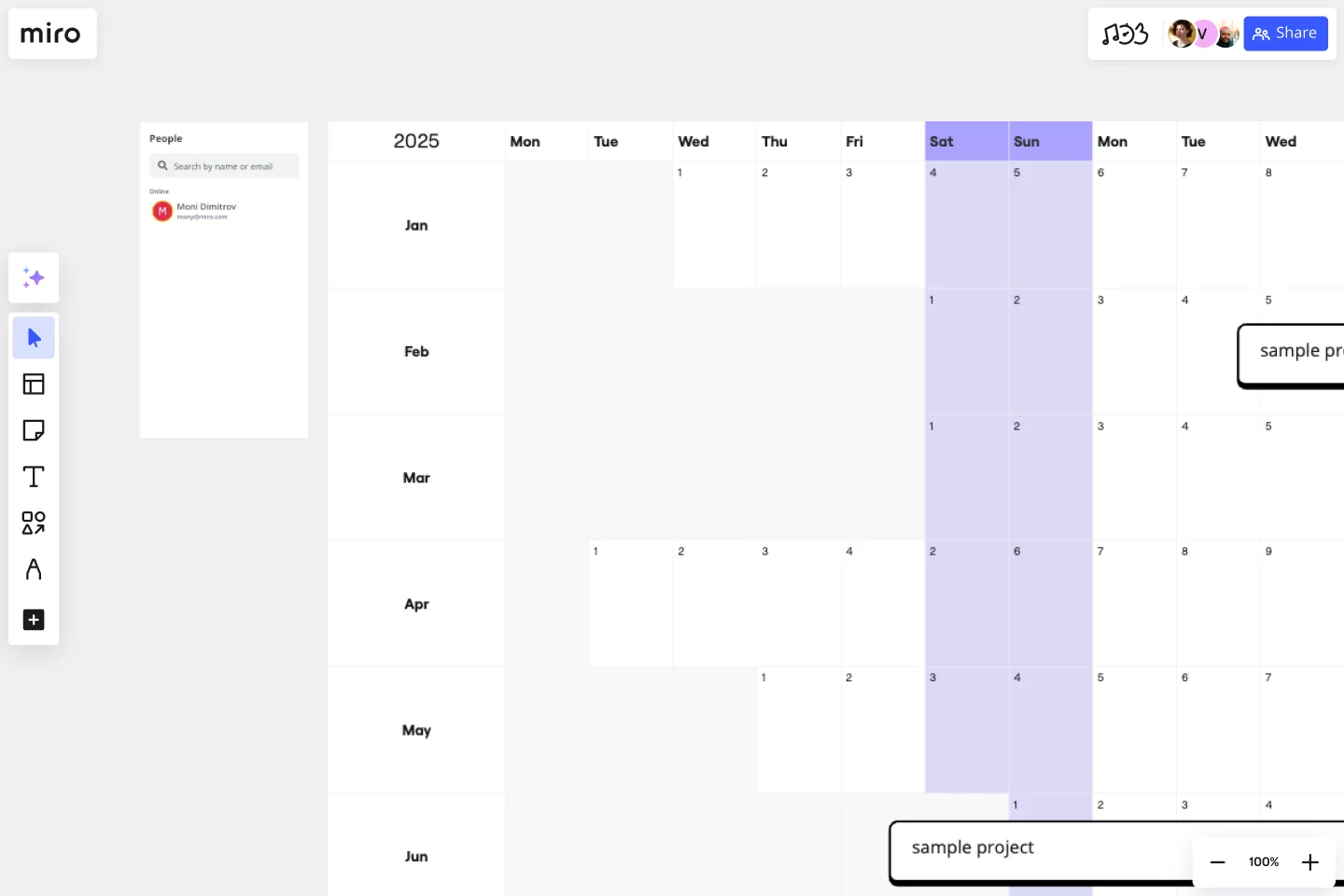Project Timeline Template
Use the project timeline template to translate complex details into visual clarity and ensure smooth project progression.
About the Project Timeline Template
The project timeline template streamlines the planning and execution of tasks, ensuring stakeholders remain informed, on track, and aligned with the project's objectives. As teams evolve and businesses expand, a comprehensive timeline becomes pivotal to managing complex projects with varying dependencies.
This project timeline template consists of a calendar containing tasks, milestones, and deliverables. It provides an overview of what needs to be done, by when, and in what order, allowing teams to visually understand the flow and dependencies of individual tasks within a project's lifecycle.
How to use the project timeline template
Using the template is straightforward. Edit the timeline with just a few clicks to reflect project-specific details. Here is a step-by-step guide on how to use the project timeline:
Step 1. Add project details
Click on any calendar cell to add your project info. Add the tasks or milestones as needed.
Step 2. Expand as required
Should your project span a more extended period or contain more details, you can quickly expand the template. Click and drag the edges to add new rows to the calendar.
Step 3. Incorporate additional artifacts
If you need to reference other items or details, drag and drop files directly onto your board, adjacent to or within the timeline, for an integrated view.
Step 4. Adjust and refine
Periodically revisit the calendar as the project progresses. Adjust as necessary, reflecting any project scope or timeline changes.
Step 5. Save and share
Save your changes once you’re happy with your timeline's details and layout. You can then share the board link with team members or stakeholders for collaborative viewing and editing.
Why should you use a project timeline template?
Clarity and visualization: The template translates complex project details into a digestible format, enabling team members to quickly grasp the project's scope and timeline.
Improved collaboration: Providing a single source of truth ensures that all team members are aligned, reducing miscommunication and ensuring everyone is on the same page.
Efficient resource allocation: Teams can foresee when peak workloads might occur, allowing for better resource distribution and prevent bottlenecks.
Tracking and accountability: An updated project timeline template serves as a reference point for progress tracking, helping to hold team members accountable for their responsibilities.
Flexibility in planning: When unexpected changes occur, teams can adjust timelines, ensuring the project remains on course while accommodating unforeseen obstacles.
Discover more project charter templates to simplify your planning.
Can I customize the template to fit longer-term projects?
The template is designed to be flexible, allowing you to adjust it to accommodate projects of any length.
Can the timeline be integrated with other tools or platforms?
While this specific template is designed for use on a board, it's structured in a way that allows for smooth integration with most project management tools, include Jira cards and Google Workspace.
How can I share the timeline with stakeholders who don't have access to the board?
You can export the timeline as an image or PDF, ensuring stakeholders remain informed, even if they don't have direct access.
Get started with this template right now.
Vision Board Template
Works best for:
Strategy & Planning, Product Development
Miro's Vision Board Template helps teams to bring their vision to life. From visual representation to real time collaboration, this template facilitates planning, execution, and achievement of any project's goals.
Entity–Relationship Diagram (ERD) HR Management System Template
Works best for:
ERD
The Entity–Relationship Diagram (ERD) HR Management System Template in Miro is designed to streamline the management of employee-related information and processes within an organization. This template allows for the visualization and organization of complex HR systems, making it easier to understand relationships and processes. It enables users to map out departments, positions, and employee details, including attendance records, payroll, and performance reviews.
Service Blueprint by Liz Possee Corthell
Works best for:
Service Blueprint
Enhance your service design with the Service Blueprint Canvas. This template helps you visualize and analyze the entire service process, from front-stage customer interactions to back-stage support activities. Identify pain points, optimize workflows, and improve customer experiences. Ideal for service designers, managers, and teams focused on delivering exceptional service. The blueprint provides a comprehensive view, facilitating better communication and strategic planning.
Prioritized Product Roadmap
Works best for:
Roadmap, Mapping, Planning
The Prioritized Product Roadmap template enables teams to focus on delivering the most valuable features to customers. By prioritizing initiatives based on impact and effort, teams can maximize the return on investment and drive business value. This template fosters collaboration and alignment, ensuring that development efforts are aligned with strategic objectives and customer needs.
UML Class E-Commerce System Template
Works best for:
UML
The UML Class E-Commerce System Template streamlines the process of creating and visualizing the class structure of an e-commerce system. It provides a comprehensive framework that includes typical online shop features such as product listings, inventory management, shopping carts, orders, payments, and shipping details. This template facilitates a clear understanding of how these elements interact during an online sales transaction, making it an invaluable tool for teams working on e-commerce projects. By using this template, teams can save time, enhance collaboration, and ensure that their system architecture is robust and efficient, ready to adapt to their business's evolving needs.
Outcome Mapping Template
Works best for:
Diagrams, Mapping, Project Management
Use Miro’s outcome mapping template to improve your operational efficiency. Outcome mapping will help you visualize all the possible strategic outcomes for your upcoming project, allowing you to see into the black box to identify any potential challenges along the way.

